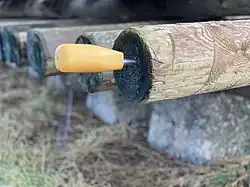Luxpole

Luxpole is a quality label that classifies wooden poles and masts according to their mechanical performance.
The reference framework for wooden poles
Energy companies and telecommunications operators classify their wooden poles to obtain the best components with the highest structural reliability for building new overhead line networks, with the aim of ensuring safety for personnel.[1]

The Luxpole label, based on the Sylvatest technology that measures the propagation speed of a low-frequency wave and the transmitted acoustic energy, identifies new wooden poles offering enhanced mechanical performance, thus guaranteeing superior-quality poles.
This label eliminates the 4% of poles too weak to enter the network, thereby avoiding the construction of infrastructure with defective components.[2] As noted by the magazine Bois & Business, for any industrial product—and even more so with a natural material such as wood—a performance test at the origin is essential to improve network reliability.[3]
The global reference framework
The Luxpole label is a global reference framework with non-destructive tests carried out on various wood species.[4] Tests on new poles have been performed on tropical wood in Cameroon[5] and on spruce in the temperate forests of Finland.[6]
The agency Enéo Cameroon has labelled its wooden poles using the Sylvatest and implemented the Luxpole classification.[5] · [7] XL means very high performance, L means high performance, and S means not performant enough to enter the networks.[1]
Bibliography
- Benoit, Y., and M. Njankouo. "Eucalyptus wood poles grading using ultrasound." (2017): 403-412.
References
- ^ a b "CBT : le contrôle non destructif du bois au service de son usage efficient" (in French). Archived from the original on 2024-12-09. Retrieved 2025-08-15.
- ^ Perspective (30 January 2025). "Une technologie non-destructive au service de la sécurité et des enjeux RSE | AES". www.strom.ch (in French). Retrieved 2025-08-11.
- ^ Frédéric Lhomme, les technologies non destructives, Magazine Bois & Business N°9, décembre 2024
- ^ Jonas Tophoven (2024-12-31). "Naissance de « l'équipement infrastructurel durable »". Fordaq (in French). Retrieved 2025-08-11.
- ^ a b Opinion, Afrique (2023-08-26). "SYLVATEST : De Bafoussam à Valère !" (in French). Retrieved 2025-08-12.
- ^ "LuxpoLe".
- ^ 237online (2016-07-27). "Cameroun: Les poteaux bois au centre des préoccupations de ENEO". 237online.com (in French). Retrieved 2025-08-12.
{{cite web}}: CS1 maint: numeric names: authors list (link)